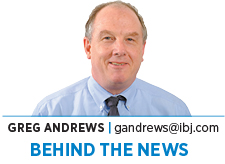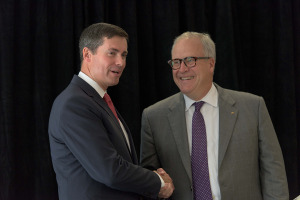Subscriber Benefit
As a subscriber you can listen to articles at work, in the car, or while you work out. Subscribe Now When Eli Lilly and Co. sneezes, Indianapolis catches a cold, as the saying goes. But the reverse is also true: When the company is flourishing, the positive repercussions reverberate throughout central Indiana.
When Eli Lilly and Co. sneezes, Indianapolis catches a cold, as the saying goes. But the reverse is also true: When the company is flourishing, the positive repercussions reverberate throughout central Indiana.
The drug-development business is inherently hit and miss, with some setbacks even in the best of times. So if you follow the daily drumbeat of news emanating out of Lilly Corporate Center, you might not grasp how phenomenally well the company is poised to perform in the coming years.
You also might not have realized that Lilly shares, which traded for as little as $29 in the Great Recession, recently surged past $200, setting all-time highs along the way. The stock is up 55% since late October, a surge that added $68 billion to Lilly’s market value.
Much of the recent climb was fueled by optimism over Lilly’s Jan. 11 announcement that a phase II trial for its Alzheimer’s treatment donanemab found a significant slowing of decline for patients in the early stages of the disease. More testing is needed, of course, though the results understandably have scientists hopeful they’ve achieved a breakthrough in their decades-long quest to rein in one of the world’s most debilitating diseases.
Yet one of the reasons analysts say they are high on the stock is that it isn’t built on the potential sales firepower of just a handful of drugs. Rather, they say Lilly is well-positioned thanks to its own research successes, combined with CEO David Ricks’ aggressive deal-making to further prime the pipeline.
The investment firm Cowen said Lilly is poised to report compound annual growth in earnings per share of 15% through 2025, significantly outperforming Cowen’s forecast for 9% growth for the entire industry.
Cowen predicts Lilly’s sales will march steadily higher during that period, rising from $24.5 billion in 2020 to $36.9 billion in 2025.
The company’s outlook is so bright that the stock might rise as high as $232 in the next 12 months, the investment firm CFRA said in a report.
“In aggregate, the company looks well-positioned to drive top-line growth,” Morningstar analyst Damien Conover added in a report. “We project annual sales increases of 11% during the next five years as a result of new drug launches offsetting patent losses.”
Building wealth
Asked three decades ago what would happen if Eli Lilly were acquired, then-Mayor Stephen Goldsmith famously quipped, “God would not let that happen.”
The comment underscores the outsized role the pharmaceutical company plays in central Indiana—both in driving the economy and in enhancing quality of life. The region’s economy is diverse, but Lilly is such a behemoth that its ups and downs ripple across the region.
“Lilly’s impact on the community is very deep,” said Morton Marcus, a retired Indiana University economist. “The company is held in such high regard by the people of Indianapolis that a new family moving in gets treated as superstars. It is not the money alone, but the halo around the company that is so selective in its hiring.”
The company has 10,843 Indianapolis employees, a workforce that’s more secure when the company is growing than when it’s on its heels.
In addition, the company’s shares are widely held across the region, especially by current and former employees—creating wealth in good times and shrinking it in bad.
Consider the impact of the runup in the share price just on Ricks, a Lilly employee since 1996. He owns 343,639 shares worth $69.7 million—$24.9 million more than they fetched in October.
But that’s peanuts compared with the impact on Lilly’s largest shareholder, the philanthropic powerhouse Lilly Endowment Inc. It owns 111.1 million shares worth $22.4 billion—$8 billion more than the shares fetched four months ago.
The tax code requires that charitable foundations give away at least 5% of their assets annually. The endowment calculates that value using average monthly value over the course of the year, which blunts the impact that sudden swings in the value of assets have on grant-making.
Still, 5% of $8 billion is $400 million. So if the runup holds, the organization will have hundreds of millions of dollars more to give annually, largesse that it historically has concentrated in Indiana.
Tough times

It wasn’t that long ago that Lilly’s ability to thrive and remain independent looked very much in doubt.
In August 2000, a federal appeals court invalidated the patent protection for its blockbuster antidepressant Prozac—sending the company’s shares down $31 in a matter of hours.
It was a surprise ruling, one that triggered a multiyear swoon in the stock price fueled by investor angst that the company was too reliant on a handful of remaining blockbusters with soon-to-expire patents and didn’t have enough in its R&D pipeline to replace them.
Indeed, back in the dark days of 2010, as then-CEO John Lechleiter looked forward through 2014, four blockbusters—the cancer drug Gemzar, the schizophrenia treatment Zyprexa, the antidepressant Cymbalta and the osteoporosis medicine Evista—were set to lose patent protection, opening the door to a flood of generic competition.
Together, the four generated 48% of Lilly’s $21.8 billion in 2009 sales.
Some at the time saw Lilly’s go-it-alone strategy as foolhardy. “It’s a very strange position they’re taking, considering what they’re facing,” Standard & Poor’s analyst Herman Saftlas told Reuters in 2010. “They have to do something or the patent cliff will kill them.”
Lechleiter’s leadership team proved the naysayers wrong, replenishing the pipeline with a broad range of treatments, many of which are now powering Lilly’s sales.
“We’ve paid particular attention to putting the company in a position where we do not have to go through the boom-and-bust cycle that’s characterized the last 10 years,” Lechleiter said in 2015, a year before he retired and turned the reins over to Ricks.
Stoking sales
In 2020, 11 drugs that have launched since 2014 generated $12.5 billion of Lilly’s $24.5 billion in sales. The top performer was the type 2 diabetes medicine Trulicity, which racked up sales of $5.1 billion, up 23% from 2019.
Analysts say Trulicity has lots of mileage left. It isn’t set to lose patent protection until 2026, at which time, Cowen estimates, it will have annual sales of $8 billion.
Still, the company will continue to face the usual juggling act of rolling out new drugs to offset those going off patent. But it’s been having success doing so. It weathered, for instance, the patent expiration for the erectile dysfunction drug Cialis, which had peak sales of $2.5 billion before generic competition arrived in 2018.
The next top Lilly drug to lose patent protection will be the lung cancer medication Alimta, which generated $2.3 billion in sales in 2020 but will face U.S. competition in 2022.
Ricks sounds confident Lilly has plenty of firepower to prosper in the coming years.
In a conference call with analysts on Jan. 29, he highlighted three pipeline drugs: the Alzheimer’s treatment donanemab; tirzepatide, which is in phase 3 development for type 2 diabetes and for chronic weight management; and LOXO-305, which is beginning phase 3 testing for certain leukemias and lymphomas. Lilly scooped up the cancer drug as part of its $8 billion purchase of Connecticut-based Loxo Oncology in 2019.
“Each [has] a chance to significantly improve patient outcomes in areas of high unmet medical need,” Ricks said on the call. “We believe these are three of the most important and exciting pipeline assets in our industry and provide meaningful support for Lilly’s growth potential beyond 2025.”
Ricks also expressed high hopes for Verzenio, a treatment for breast cancer that won U.S. Food and Drug Administration approval in 2017 and has recently been buoyed by new study data showing it reduced the risk of breast cancer recurrence 25% more than another treatment approach.
The new data represent a significant treatment advance in an earlier stage of breast cancer. The drug already has treated tens of thousands of people with advanced-stage breast cancer.
“Together with Verzenio data in early breast cancer last summer, we have significantly reinforced our growth prospects for the midterm and upgraded them for the long term,” Ricks said on the call.
Analysts are high on all four. Cowen forecasts Verzenio sales will increase from $913 million in 2020 to $5.3 billion in 2025.
The outlook for earlier-stage drugs is inherently more uncertain. Consequently, in its report, Cowen lists donanemab as a potential sales driver but left projected sales blank.
However, Muizho analyst Vamil Divan was willing to go out on a limb in a report, setting the odds of donanemab’s coming to market at 60% and saying it could reach peak annual sales of $11 billion.•
Please enable JavaScript to view this content.

